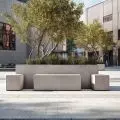Pavilions and buildings characteristic of the architecture of the 1960s,1970s in the 1990s and later disappeared from the face of the earth, were converted into office buildings or shopping centers. "Emilia" was one of the last examples of modernist design in downtown Warsaw. A modern skyscraper is to stand in its place. Upon hearing the news, BBGK Architects decided to act.
Usually it is the client who comes to the designer with a specific idea. In this case it was different - the "Emilia" pavilion was to be demolished overnight. So the project had to go a completely different way. For a year and a half the BBGK Architekci team worked out a way for the pavilion to remain part of the urban fabric of Warsaw after all. Michal Krasucki - the capital's historic preservationist and modernist architecture aficionado - found a provision in the local plan stating that the edge of Swietokrzyski Park was designated for the construction of an orangery. On the axis of the Palace of Culture a place was designated for the construction of a low glass building. "Emilia" fit into this almost perfectly.
The location of "Emilia" until recently
© BBGK Architects
Relocation the only solution
Griffin Polska - the owner of the plot - obtained all permits - legally and formally the pavilion no longer existed. The only way to save it, was to move it to another location. There are several lovers of historic buildings in the BBGK Architekci office. Michal Krasucki himself, who was involved in saving the pavilion, is a member of the Society for the Care of Historic Buildings. The designers entered into cooperation with Piotr Pachowski, a constructor, who worked out how to dismantle and relocate "Emilia."
With full documentation, including marketing materials, the architects went to talks with the City Hall of the capital city, in which the owner of the plot also participated. The negotiations yielded an agreement - Warsaw allocated the edge of Swietokrzyski Park for the pavilion, and investor Griffin Polska made a record donation for its relocation. Thanks to Piotr Pachowski, "Emilia" was cut into pieces and safely stored in a recliner - a kind of bed covered by a steel frame.
The new location of "Emilia"
© BBGK Architects
The initiators of the project, Wojciech Kotecki and Michal Krasucki, among others, wanted the new "Emilia" not to be a recreation of the original building or its reconstruction. The goal was to create an authentic building consisting of as many original elements as possible. Unfortunately, the pavilion was made of poor-quality materials that are simply falling apart today. What was able to be preserved was cut up and assembled on a plot of land on Towarowa Street.
The idea was very well received by the public. There were also critical voices showing that in its new location "Emilia" is detached from its original context. As Wojciech Kotecki points out - it is impossible not to agree with this. However, the pavilion was designed to be surrounded by trees on all sides. Until recently, it was suffocating between the high-rise buildings that had sprung up on the green parcels of land that once surrounded it. The sole surviving author of the project, Ms. Hanna Lewicka, was complicit in moving the pavilion. She said that with the change of location, "Emilia" is regaining its original context.
"Emilia" furniture house today
Modernist buildings were designed by the best architects of the time, and were built in city centers, their top locations. After 1989, free market pressures caused these "gems" to disappear, one by one. What remained was "Emilia" - an icon of communist pop culture, appearing in many Polish films.
Today's situation of the pavilion is a kind of compromise. It is no longer a furniture house - they simply do not exist today. No one knows what a furniture house is, nor are pavilions being built. The new "Emilia" becomes a symbolic monument to the now defunct gems of Modernism architecture, which unfortunately could not be saved. It will not be the same "Emilia" - this one carries a completely new architectural content.
The new "Emilia"
© BBGK Architects
The pavilion in its new location will meet modern technical and functional requirements. The above-ground part will become an orangery - a meeting place where one can enjoy a cup of coffee amidst the greenery. The underground part is almost 3,000 square meters with a height of one and a half times that of the original basement. It is intended to be a multifunctional space - conference, exhibition, workshop. This is what will depend on the private investor, who will be selected in a tender announced by the City of Warsaw.
What will happen underground depends on the results of the tender. Our commitment, my commitment, is that this building will be built. He does not want to be responsible only for its dismantling. Michal Krasucki and I are obliged to make it happen. We just have to do it. This is our contribution to the defense of the heritage of modernism. - says Wojciech Kotecki of BBGK Architects.










































